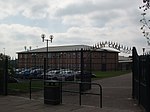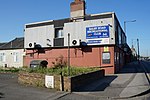St Catherine's Hospital, Doncaster
1928 establishments in EnglandBuildings and structures in DoncasterDefunct hospitals in EnglandHospitals established in 1928Hospitals in South Yorkshire ... and 1 more
Use British English from March 2018

St Catherine's Hospital was a mental healthcare hospital located in Doncaster, South Yorkshire, England, approximately three miles (4.8 km) from its centre. It is managed by Rotherham Doncaster and South Humber NHS Foundation Trust.
Excerpt from the Wikipedia article St Catherine's Hospital, Doncaster (License: CC BY-SA 3.0, Authors, Images).St Catherine's Hospital, Doncaster
Huxterwell Drive, Doncaster Alverley
Geographical coordinates (GPS) Address Nearby Places Show on map
Geographical coordinates (GPS)
| Latitude | Longitude |
|---|---|
| N 53.495 ° | E -1.146 ° |
Address
Tickhill Road
Huxterwell Drive
DN4 8TF Doncaster, Alverley
England, United Kingdom
Open on Google Maps







